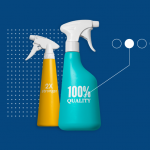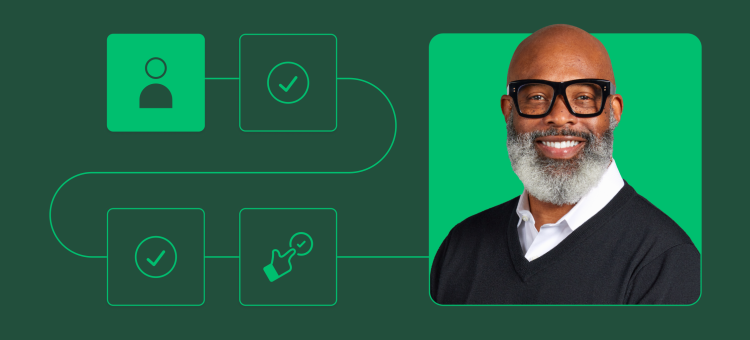According to a 2015 Microsoft study, the average person has a shorter attention span than a goldfish. (Though, to be fair, most goldfish don’t have iPhones.) For marketers, that means that you have around three seconds to convince consumers that they need to buy your product. How do you choose the line (or two, or maybe three) that will win them over?
In this guide, we explore a marketing framework that Jeremy Benhammou, the associate director of global insights at The Clorox Company, created with his colleague Global Insights Manager Hagar Zohar to help answer that question. We’ll also give you step-by-step instructions for how to build your own successful marketing claims. Here’s what you’ll learn:
- Understanding the 3 kinds of marketing claims:
Benhammou’s breakdown of the three ways that you can use marketing claims to get ahead - How to sift golden marketing claims out of your market:
Tips for using customer surveys, market research, and competitor tracking to originate powerful marketing claims - Gut-check your claims before they body-check you:
Benhammou’s breakdown of which stakeholders need to be involved in making new marketing claims, and why - Turning a hypothesis into a real-life marketing claim:
A guide for how to use concept testing to understand how your marketing claim will perform, and how to refine it into the best possible wording
Origins of the Clorox framework
Jeremy Benhammou is one of the most successful professionals in the insights industry, but he credits much of his success to an early failure.
Several years ago, a woman in a focus group gave Benhammou what he thought was a flawless marketing angle: The participant said that she chose Clorox’s Glad trash bags because she didn’t have to double-bag them—meaning she ultimately ended up using fewer bags.
Thrilled, Benhammou conducted some additional research, which found that Glad customers typically use 60 fewer bags per year. His team decided to use the statistic in a major marketing campaign, believing that people who saw the claim would immediately understand the value of choosing Glad bags, and buy accordingly. He was wrong.
Contrary to expectations, Glad sales plateaued throughout the campaign. Benhammou decided to use the opportunity to take a closer look at the factors that determine what makes a successful product claim. He and Zohar did a deep analysis, and eventually created a new framework that allowed them to identify exactly what went wrong and changed the way they create, evaluate, and test product claims.
This guide will first explain Benhammou and Zohar’s theoretical framework, then give you step-by-step advice for putting it into practice, using surveys.
Related: How to perform product positioning
What are marketing claims? Understanding the 3 kinds of marketing claims
A marketing claim is any assertion you make about your organization, brand, or product—across any channel. It can show up in traditional marketing or advertising, digital promotions, public statements, or even on product packaging.
There are many different ways to structure your product claims—superlatives (“we’re the best!”), proof points (“we’re made of 99% ingredient A!”), or even simple statements (“we do the thing so you don’t have to!”)—but all claims can be bucketed into 3 main types of consumer benefits, each with their own business objective, according to Benhammou.
1. Category driver: Category driver claims explain the benefit of the entire product category. At the most basic level, they explain why consumers need the product. Since category driver claims communicate a basic consumer need, they don’t change much over time or vary by location.
The main goals of category driver product claims are to educate consumers, reassure them, or develop a category that consumers don’t yet understand. This is how companies that are doing something new explain what they offer and why people need it. Typically, only category leaders (like Clorox, in the bleach category) and companies with a unique offering can get away with only using category driver claims in their marketing or product packaging.
2. Differentiation: Category driver claims work when you’re the industry leader or first to market. Otherwise your claims need to differentiate your brand from your competition. They answer the question, “Why should I choose your brand over all the others?”
Differentiation product claims showcase your brand’s relevant and unique benefits. They address real consumer pain points and help justify why retailers should put more of your products on their shelves.
For Clorox, Glad is a brand that requires differentiation because, although it is the category leader, it has competition from brands like Hefty.
3. Context. Context product claims go one step deeper than the “what” and the “why,” and dig into the “how,” “where,” and “when.” Context claims cover issues relevant to specific countries, channels, retailers, seasons, or current events. They often take advantage of the unique environment where they’re published or promoted.
Context claims are more timely. Maybe it’s cold/flu season, or it’s almost time for the Super Bowl, or your city is experiencing a heat wave. Context claims are usually temporary, but they can make strong points.
How to sift golden marketing claims out of your market
1. Ask your customers. When you’re looking for a new selling point, often the best place to start is with people you’ve already sold. Existing customers can be a great source of all three types of product claims, because they have real-world experience of the types of benefits your claims will highlight.
If you want to find out exactly what your most satisfied customers love about your product, you can use a customer satisfaction survey to get some instant insight. Sometimes you’ll end up with a product angle you haven’t used in marketing before (our product is easier to use than our competitors!), or a new statistic (99 percent of our customers love our special features!). You can use one of our customer satisfaction survey templates as a basis, or design your own.
Here are some example questions that you can think about asking your customers:
- Why do you prefer our brand? (Include a list of options to choose from, listing your product’s best value propositions.)
- How much time, money, or effort have you been able to save since you started using our product?
- If you considered other brands, why did you choose ours?
- Please complete the following sentence: 'Our brand makes it easy to _____.'
Tip: If you’re using a SurveyMonkey survey, start by asking your customers to rate their satisfaction, and use elimination logic to immediately end the survey for people who aren’t totally satisfied. It’ll ensure that your results reflect the positive aspects, and spare your not-so-satisfied customers the frustration of filling out an irrelevant survey.
2. Survey your target audience. If you’re trying to grow your product’s appeal or target a new market, customers might not be able to tell you anything you don’t already know. That’s why, when pursuing a context claim, your best bet might be doing a little market research.
Start by seeing if anyone has already done your work for you by looking through existing reports. (Remember to check the sample size, methodology, and publication date to ensure the data is still relevant.) This can also help you refine the types of questions you might ask in your own market research.
Whether you want your claim to reach specific groups like millennials with iPhones, or moms in the Netherlands, or just U.S. shoppers, you can use market research surveys to get more clarity about what that group cares about.
Tailor your survey to the areas where you think your business has the best chance of standing apart. Before you send it, check out these market research best practices from SurveyMonkey’s expert research team to make sure you’re getting the most accurate results. You can also use our sample size calculator to figure out how many people you need to survey in order to get an accurate read on your market.
Tip: If you’re having trouble getting enough respondents, or want to access a very specific group of people, you might want to use SurveyMonkey Audience, which lets send surveys to a panel of survey-takers, divided up by demographic.
Find out what your market thinks
SurveyMonkey Audience lets you customize your demographics and collect responses in real time, so you can start drawing data-based conclusions in minutes.
3. Check out your competitors. Doing competitor research might give you ideas about what your potential customers care about, warn you away from product claims that don’t work, or give you angles for potential differentiation claims. Look at both what they’re saying and what they are not talking about to see where you can set yourself apart.
Tip: You can track competitors’ web traffic with Google, SimilarWeb or even Amazon’s Alexa, SEO monitoring tools like SE Ranking, or you can just look at their social media interactions (especially if they have posts that make the specific claim that you’re interested in.)
Gut check your claims before they body check you
On the surface, it may seem like the quality of a claim should be obvious (does it make your product look good, or not?), but it’s deceptively easy to overlook something important, and it happens to major companies all the time. The fallout for a miscalculation can be harsh—you might just miss growth goals, like Benhammou’s team, or you might face intense backlash for misleading customers, or even lose millions of dollars.
Often, claims fail because marketers don’t consider one of the other players that factor into a product’s success. That’s one area where the Glad campaign in the intro to this guide fell short.
According to Benhammou, “Good claims satisfy consumer needs, business objectives, and cross-functional priorities.” In other words, marketing claims are a balancing act between attracting customers, meeting your organization’s goals, and staying true to the facts.
One of the things that Benhammou’s team didn’t consider when they launched their campaign was the fact that Glad technically has two kinds of customers: the ones that purchase trash bags for home use and the ones that make the decision to put Glad on the shelf in the first place—the retailers. In this case the grocery stores that were selling Glad trash bags were also the ones selling those “inferior generic brands,” and they weren’t happy about the poor comparison. It made salespeople’s jobs harder, and after realizing that, Benhammou was quick to involve the sales teams early in his next initiative.
Questions to ask your sales team:
- Can we turn this claim into real revenue?
- Does it resonate with our prospects?
- How can we tell compelling customer, shopper, and point of sale stories?
Benhammou identified four important corporate stakeholders that should have input before any new marketing claim goes public: sales, product/R&D, brand, and insights.
Failing to communicate with your product team, who can help you be certain your marketing promises are actually true, is probably the most dangerous mistake marketers can make. Consider infamous false advertising suits like the ones against Activia’s “scientifically proven” claim to aid digestion, or New Balance’s promotion of its purported calorie-burning sneakers a strong warning against making your claims too exaggerated. Lean on your product team to keep you grounded in the facts, and also for sharing all the juicy new details of product you’re marketing.
Questions to ask your product/R&D team:
- What does the product do that other brands don’t?
- Are there new features?
- Is there anything unique about the way the product works?
- Is the claim we’re thinking about making true?
- Could our product fail to deliver on our product claims?
The importance of insights and brand probably go without saying. Ultimately, marketing claims should move you closer to your long-term business goals, which means you don’t want to claim that alienates potential corporate partners, or use slang that won’t make sense to a new audience you’re targeting.
Questions to ask your insights team
- What pain point is the product solving? How universal is it?
- Are our potential claims unique?
- What kind of language would feel the most relatable to consumers?
Questions to ask your brand team:
- Does the claim support our long-term growth strategy?
- Does it echo our company values?
Working with other teams early on in the marketing process will also help you uncover opportunities.
Benhammou’s team recently implemented a highly successful packaging update in Argentina, a market they were interested in growing. Benhammou’s market research showed him that when it comes to household cleaning, Argentinians are interested in efficiency.
Through conversations with the product team, Benhammou realized that new Clorox gel formulas, which could be directly applied to surfaces, were more far quicker to use than standard bleach. His team also found that people in the area were confused by the new gel formula, and understanding what made it different. He saw this as an opportunity to educate, and showcase the exact benefits that Argentinians were interested in.
People who use Clorox’s gel formula get all the benefits of cleaning with bleach—near total disinfection, easy stain and soil removal—without the harsh smell, need to dilute in water or risk of splashing it out of the jug. He decided to wrap that all those benefits up into a single category-driver product claim: “ideal for direct use.” It worked well.
Turning a hypothesis into a real-life marketing claim
Once you’ve discovered a great angle and put it through Benhammou’s stakeholder framework, you can start to try it out on your most important audience: potential customers.
Using surveys for concept testing lets you test your marketing claim out on your audience before you invest the time and resources to do a full marketing push. It also helps you avoid potential risks. Is one angle better than another? What about the wording—could choosing one adjective instead of another change your results?
Your concept testing survey should start with a goal. You can use concept testing early on to test different marketing angles against each other (should we focus on our product’s health benefits, or its flavor?), or later in the pipeline to see how different word choices impact perception (is “delicious” better than “tasty”?). You can survey existing customers, or a random sample of the market, depending what your goals are. Use our messaging claims template as a springboard to get you started.
Tip: Use a multi-part rating system called the Likert scale for more accurate findings about the strength of your claim. Our Ultimate guide to concept testing explains why and gives detailed guidance about how to design, test, and analyze concept testing surveys.
Here are a few general tips for the wording and structuring of your marketing claims as you experiment with different phrasing:
Be tangible. In general, specific, unambiguous product abilities or differentiations are more powerful than vague statements. “Our product is better for your heart” is a stronger claim than “we’re better than our competitors.”
Be clear. Your marketing claims should make the customer benefit immediately apparent. Don’t expect to follow logical jumps. Instead of saying, “this contains aloe,” say “this contains skin-soothing aloe.”
Keep it short. Consumers’ attention spans are tiny, and whether they’re scanning over products on a shelf or posts in a newsfeed, they’re not going to stop to read the fine print. Get your message across as quickly as possible with a claim that hovers around 3-6 words.
Stick to one. Don’t try to push more than a couple new claims at once; your message will get confused and some of your stronger claims might get drowned out. Find the claims you really love, and commit to them.
When you’ve found your claims, gut-checked them, and written and tested them positively, you’ll finally have the data-backed marketing fuel that you need to drives incredible business results. According to Benhammou:
“Unfortunately, there’s no single path that I’ve found to reliably create great claims. It’s an ongoing process of experimentation. Every piece of communication we throw out costs our customers a little bit of time and attention: it’s up to us to make the most of that attention with messages that really resonate. This framework takes some of the guesswork out of that.”
Disclaimer: The Clorox Company does not endorse any one research tool, SurveyMonkey or otherwise.



